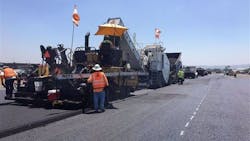Adding Value to Airfield Taxiway Construction Projects
Airport safety and operational impacts during construction can be challenging for airports, contractors and engineers when working within an active airport environment. Keys to success include appropriate design elements, comprehensive construction phasing plans and stakeholder coordination in order to maintain safe and efficient operations during construction.
At HNTB, the process includes more than just delivering the project on time and on budget. An experienced team brings added value to each taxiway design and construction project to ensure the project has minimal disruption to airfield operations.
As an example, a recent project at the Van Nuys Airport (VNY) Taxiway A and B rehabilitation program included reconstruction of two primary parallel taxiways and Runway 16L-34R. HNTB developed multi-disciplinary bid packages leveraging additive alternatives in line with the airport’s funding realities. Plans involved updating facilities to comply with FAA guidance on taxiway geometry and addressing “hot spots” on the airfield. One significant way value was added was developing tailored pavement sections to leverage existing base materials to reduce project cost and enhance constructability.
Detailed construction phasing plans at VNY limited the impacts to airport operations during construction. To achieve this critical objective, HNTB engaged with all stakeholders early in design to understand unique concerns, needs and priorities. This advance planning and coordination allowed the team to incorporate constituents’ feedback in the draft phasing plans and work toward consensus to achieve the final version.
Early and frequent coordination with the Federal Aviation Administration (FAA) was critical in maintaining the project schedule. The team coordinated directly with FAA Flight Standards to verify the visual approaches were still a viable option for VNY. On both projects, the FAA requested a Safety Risk Management Panel (SRMP). HNTB has extensive experience with these panels and was able to shepherd the projects through the panel with minimal challenges. During the SRMP, HNTB managed the process, objectives, and expectations, including anticipating and answering critical questions from the panel. As a result, the team facilitated the SRMP’s completion ahead of schedule and avoided any significant mitigations being imposed upon the project.
For Long Beach Airport’s Construct Taxiway B (Future Taxiway E) project, HNTB designed safety improvements including removal of old pavement to avoid pilot confusion. The conversion to Taxiway E helped clean up taxiway geometry to improve airfield safety. The primary goal was to eliminate FAA “hot spots” that caused safety related issues, including surface incidents and runway incursions. With the potential to reconstruct the former runway as a taxiway, both safety goals and potential revenue generation by expanding tenant leaseholds were met.
As design manager for the project, I led both design and construction support efforts. The team was successful in competing the design in just 90 days to capture and maximize available FAA AIP funds. To adhere to this expedited schedule, the design team worked closely with the airport to craft an aggressive schedule which capitalized on existing information, streamlined deliverables and allowed ample time for reviews.
From inception to completion, successful aviation project delivery encompasses more than just technical expertise, communication and project management skills. Adding value enhances and maximizes benefits for airport clients and leverages all available resources that can position airports to be more competitive, elevating safety and delivering enhanced customer service and satisfaction.
Megan Monticone, PE, serves as project manager at HNTB Corporation, based in the Los Angeles, California. She has a demonstrated history of working in the civil engineering industry with a focus on airport planning and design.




